Introduction
This brief article seeks to outline and highlight the life and culture of lac rearers and practice of lac rearing in Bastar. Through it we will try to explore some fundamental questions about lac as a forest produce and its history; following which we shall briefly look into the life of a lac rearer. We shall also explore the life of the lac insect and how all of it overlaps to provide industrial modernity a natural resin which becomes an integral part of many products that we need and consume in our daily life. I shall also try to explore through this article the socio-economic, biological and ecological challenges of lac rearing. With a limited scope I shall attempt to do justice to the far reaching yet significant events that shape the life of the rears and the reared insects who share their habitat in the forest of Bastar.
What is ‘Lac’ resin?
It is said that Lac is the oldest form of resin known to humankind. As the last week of November passes away making way for the early days of winter, villagers who own kusum, ber and palash trees start scrapping matured encrustations of stick lac of their trees. In Chhattisgarh this coincides with the harvesting season of paddy. Most of the lac which is sold by the villagers at the local haats provides them with the necessary cash to hire hands for harvesting their crops. With reciprocational exchange of labour slowly being replaced by wage labour; the quick cash from lac becomes essential for people to harvest their food crop.

Early Encrustation on a Kusum Tree
Stick lac is a resinous encrustation, formed around the bodies of microscopic tiny lac insect by its own secretions and excretions after it has been cultured on the barks of lac host trees, the most important of which are kusum, ber and palash. The resinous secretion which is known as stick lac contains about 4-5% wax and 1% water-soluble colouring material known as lac-dye (laccaic acid).
Lac resin is produced by an insect called Kerria lacca. The resin had limited usage in the adivasi life and were only used sparingly to seal pots, pans and bhurkas, but as soon as the industrial world discovered the rearing potential of the central Indian forests lac became a cash crop reared by the villagers. Lac as a resin became an economic lifeline for a significant number of forest dwelling communities as they historically started interacting with industrial modernity. Lac rearing supplements the primary occupation of the forest dwellers as cultivators and also as rearers and gatherers of forest produces. Two different strains of this species, the Rangini and the Kusumi contribute nearly 95% of the total lac production of the country. While kusum and ber can host the kusmi variety of lac insects, palash can host the rangini variety of lac. Kahir, babul and arhar trees can also host different strains of the lac insect but are not commercially viable. The rangini strain doesn’t thrive on kusum (Schleichera oleosa) but performs well on other host plant species. It is a bivoltine strain having four months (rainy season) and eight months (summer season) life cycle. The kusumi strain on the other hand has a more or less two-equidurational life cycle in a year and prefers kusum (Schleichera oleosa) for production of light coloured resin of superior quality with respect to life and flow.
Stick lac is converted to commercial grades of seed lac and then shellac. The yield of processed lac from stick lac varies between 40-60% depending on the host tree, area of cultivation and other factors. Apart from lac resin, stick lac contains 6-7% of lac wax, 3-5% of water moisture, coloring matter (lac dye), and impurities like insect remains, wood pieces, sand, etc. The refinement of stick lac into seed lac is mostly carried out in cottage or semi mechanized factories. After refinement, seed lac is converted to shellac by hand-made or machine-made process.
In the pre-industrial era gatherers would collect them whenever they required natural adhesive, they did not culture it artificially. Modern industrial demand introduced artificial inoculation of the insects on their host plants; the practice of artificial inoculation also has a long history dating back to the Indus valley era, later during the Mughal era European monarchs had also sent various research contingents to the subcontinent to study the resin generating insects. Vedic and vedantic texts also mention lac (Mandal 2014). Modern scientific study of lac started much later. In 1709, Father Tachard discovered the insect that produced lac. First of all, Kerr (1782) gave the name Coccus lacca which was also agreed by Ratzeburi (1833) and Carter (1861). Later Green (1922) and Chatterjee (1915) called the lac insect as Tachardia lacca (kerr). Finally, the name was given as Laccifer lacca some also call it Kerria lacca (Samiksha).
Lac rearers of Bastar
Across southern Chhattisgarh lac rearing is done by communities who generally live in the fringes of forests. Most forest dwelling communities own kusum or palash/pharsa trees or have access to the forests which have an abundance of palash/pharsa and kusum. As one travels further south the occurrence of palash reduces and kusum increases. Most of the pharsa or palash trees are found in Uttar Bastar, Kanker district, especially around the eastern fringe of the district in Charama and Narharpur tehsil. The highest abundance of Kusum is observable in Keshkal ghati, Kondagaon, Antagarh and Bhanupratappur tehsil.
Most lac rearers of Bastar belong to Muria, Durwa, Maria, Marar, Halba, gara and various other clans of the larger Gond people of Bastar. They are primarily cultivators of millets, rice paddy and forage a whole variety of seasonal tubers, mushrooms and leaves (locally called bhaji). Lac rearing as an activity is currently done purely for cash and it can be classified as a cash crop for the adivasi population who supplement their family income with the lac they sell in the weekly markets (haats). Financially, the majority of lac rearers can be classified as the rural poor with access to only limited resources; since they belong to various endogamous groups the communities prefer to be amongst themselves and their interactions with modernity were mediated through trading channels till the recent development and proliferation of mobile phones and wireless internet services. The haats are the gateway through which a whole host of forest products including lac goes out into the circuits of global capital through a chain of traders. These products not just participate in a whole new afterlife once they become a commodity, but also play a historically crucial role in connecting the otherwise silent, self sufficient adivasi with the world of trade commerce, consumerism and exploitation.
The Lac Insect and Resin Secretion
To have a reasonably grounded understanding of lac cultivation once must delve deep into the basic biology associated with the lac insect. The adult lac insect exhibits prominent sexual dimorphism that is, the male and female insect varies in shape, size and also in the presence or absence of certain body parts.
While the male is larger in size and red in colour. The body is typically divided into head, thorax and abdomen. The head bears a pair of antennae and a pair of eyes. Mouth parts are absent so a male adult insect is unable to feed. Thorax bears three pairs of legs. Wings may or may not be found. Abdomen is the largest part of the body bearing a pair of caudal setae and sheath containing penis at the posterior end.
Female lac insects are smaller in size. Head bears a pair of antennae and a single proboscis. Eyes are absent. Thorax is devoid of wings and legs. Since the female larvae after settling down once never move again and thus eyes, wings, and legs become useless and ultimately undergo atrophy. It is female lac insect which secretes the resin. After attaining maturity, males emerge out from their cells and walk over the lac encrustations. The male enters the female cell through anal tubular opening and inside female cell it fertilizes the female. After copulation, the male dies. One male is capable of fertilizing several females. Females develop very rapidly after fertilization. They take more sap from plants and exude more resin and wax. The resinous substance, lac is secreted by certain glands present in the abdomen of the female lac insects. The secretion of lac begins immediately after the larval settlement on the new and tender shoots. This secretion appears first as a shining layer which soon gets hardened after coming in contact with air. This makes a coating around the insect and the twig on which it is residing. As the secretion continues the coating around one insect meet and fuses completely with the coating of another insect. In this way a continuous or semi-continuous encrustation of lac is formed on the tender shoots. This encrustation before emergence of larvae is called ari lac and it is scraped off the branches into stick lac before swarming of larvae.
Swarming of larvae and Brood lac
The females after fertilization are capable of producing eggs. A female is capable of producing about 200-500 eggs on average. Inside incubating chambers, the eggs hatch into larvae.
The larvae are minute, boat shaped, red coloured and measure little over half millimeter in length. Larva consists of head, thorax and abdomen. Head bears a pair of antennae, a pair of simple eyes and a single proboscis. All three thoracic segments are provided with a pair of walking legs. Thorax also bears two pairs of spiracles for respiration. Abdomen is provided with a pair of caudal setae.
These larvae begin to wander in search of suitable centre to fix them. This mass movement of larvae from female cell to the new off-shoots of host plant, is termed as “swarming”. While swarming happens in the lac encrusted branches they are cut into 15 -20 cm sections and are tied on fresh tender branches of other host trees. These swarming sections are called ‘brood lac’ or ‘Phunki’ as they can be used for inoculating lac insects on host trees for fresh crop of lac.
The stage wise process of lac rearing
Initial Pruning: Host plants such as kusum, ber and palash are pruned before monsoon so that fresh flush of shoots and leaves can emerge during monsoon. The branches less than an inch in diameter are selected for pruning. Branches half inch or less in diameter should be cut from the very base of their origin. But the branches more than half inch diameter should be cut at a distance of 1 ½ inch from the base. The branches remain tender and are ready for inoculation around the third week of December when swarming of new larvae starts.
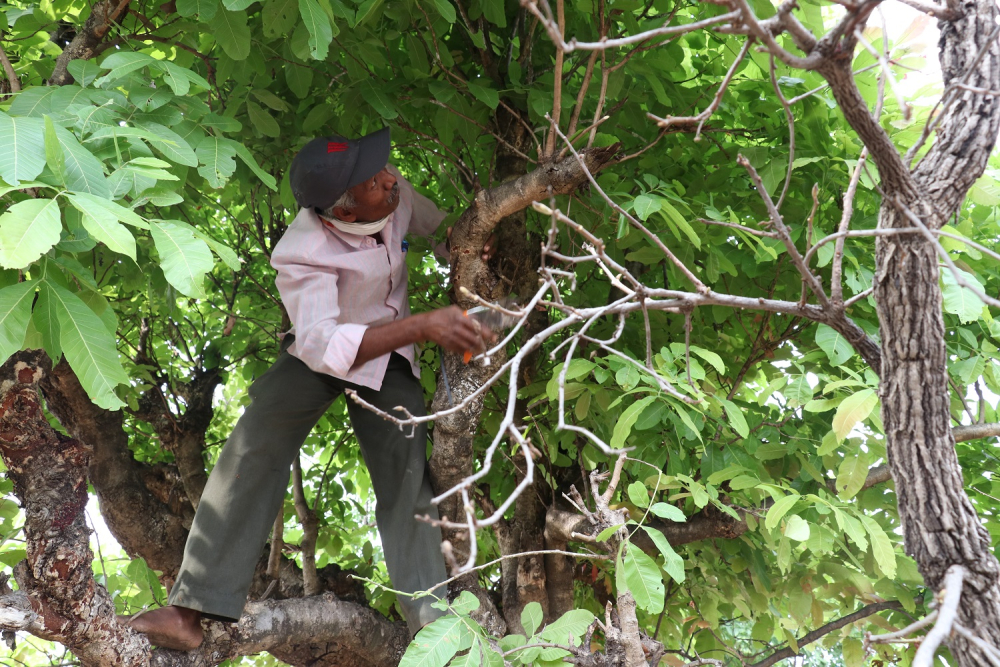
Initial Pruning
Selection and inoculation of Brood lac: Brood lac sections are prepared from a healthy swarming encrustation on a host tree. Care is taken to ensure that there are no pests or caterpillars (other insects that consume the lac insect on the encrustation). Prior to about two weeks of hatching of larvae, lac bearing sticks are cut to the size of six inches. They are called ‘Brood lac’. Brood lacs are then kept for about two weeks in some cool place.

Inoculation
When the larvae start emerging from this brood lac, they are supposed to be ready for inoculation. Strings are used for tying the brood lac sticks with the tender shoots of the host plant. There are various ways of tying the brood lac. Longitudinal infection, lateral infection and interlaced infection. In longitudinal infection brood lac is tied along the branch, in lateral infection the brood lac is tied across the gap between two branches. In interlaced method, brood lac is tied among the branches of several new shoots.
Spraying of insecticides: Lac culturist and rearers face stiff challenges from various parasites which attack lac insects.
The common parasites of lac insects are known as “Chalcid.” They are small, winged insects which lay their eggs inside the lac coat either on the body of the lac insect or inside the body of the lac insect. The larvae which hatch from these eggs feed upon the lac insects, thereby causing mortality of their host. The white moth (Eublemma amabilis) and the grey moth (Holococera pulverea) also common predators; they not only feed on lac insects but also destroy the lac produced by them.
Spraying of insecticides such as bombast spray helps prevent the parasitic and predator insects from destroying lac.
Squirrels, monkey, rats, bats and birds are also common predators which are kept at bay through physical barriers. In Bastar community people take turns to protect trees with lac from such predators, especially monkeys. (Samiksha)
Stick lac Removal and Collection: During early winter the katki crop of Rangeeni variety and Aghani crop of kusmi variety gets ready for scrapping. The ‘ari’ or the matured encrustations before larval swarming is scrapped off the branches as stick lac. The kusmi variety contains around 60-65 percent resin and the rangeeni variety contains about 58-60 percent resin. However percentage of resin also varies from place to place and is largely dependent on the health of the insects and the encrustations.
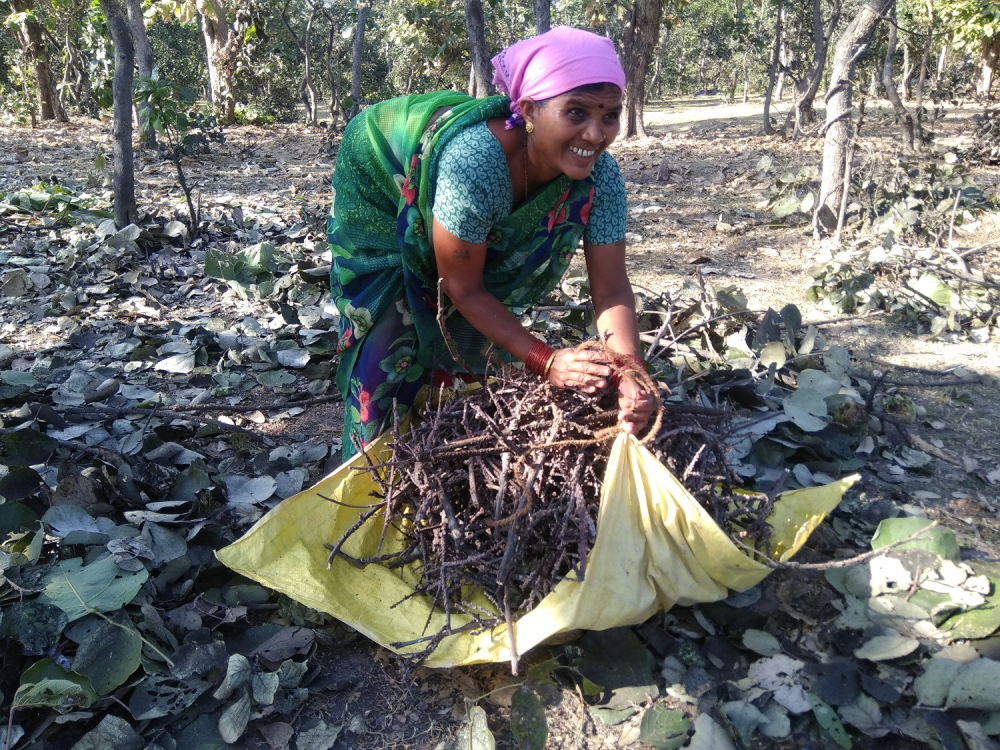
Scraping of Lac Encrustations
From Stick lac to Seed lac and Shellac:
The scraping of lac from twig is done with a knife, after which they should not be exposed to the sun.
In Chhattisgarh processing of stick lac is done in Dhamtari. There are around five major processing units which processes stick lac to seed lac and Shellac. The scraped lac is grinded in hard stone mills. The unnecessary materials are sorted out by hands and also through fine sieve in order to remove finer particles of dirt, following which the lac is repeatedly washed with cold water and is dried under sunlight. At this stage of purification it is called ‘Seed lac’. In Dhamtari, the processing units are generally owned by wealthy settlers who own large estates with open courtyards where seed lac is dried under sunlight.
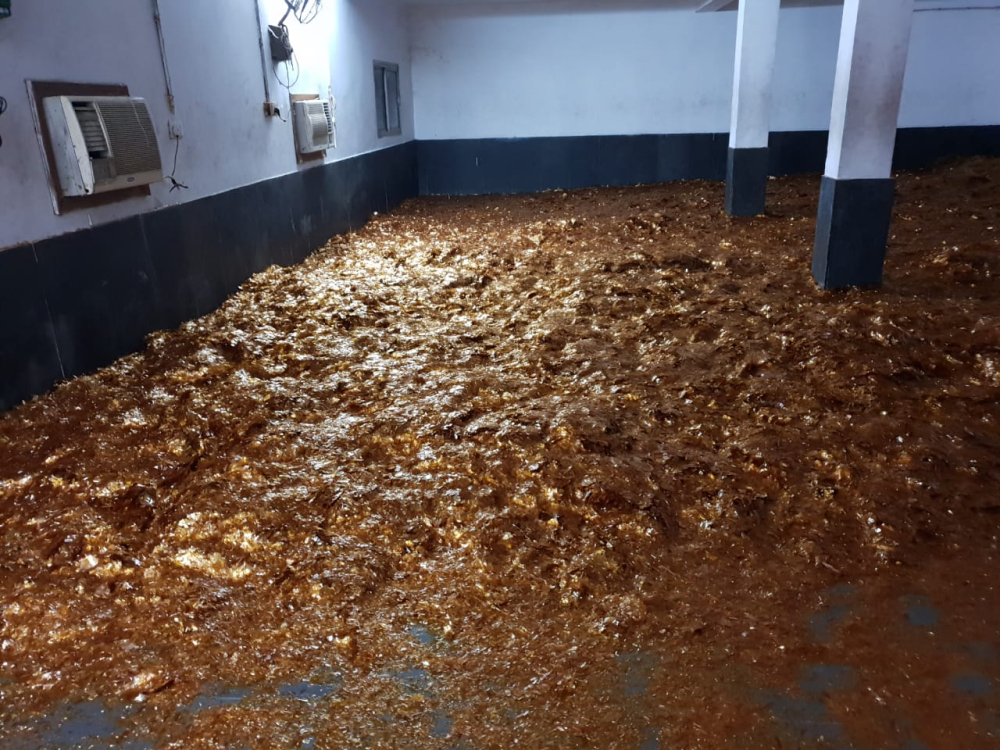
Drying of Shellac
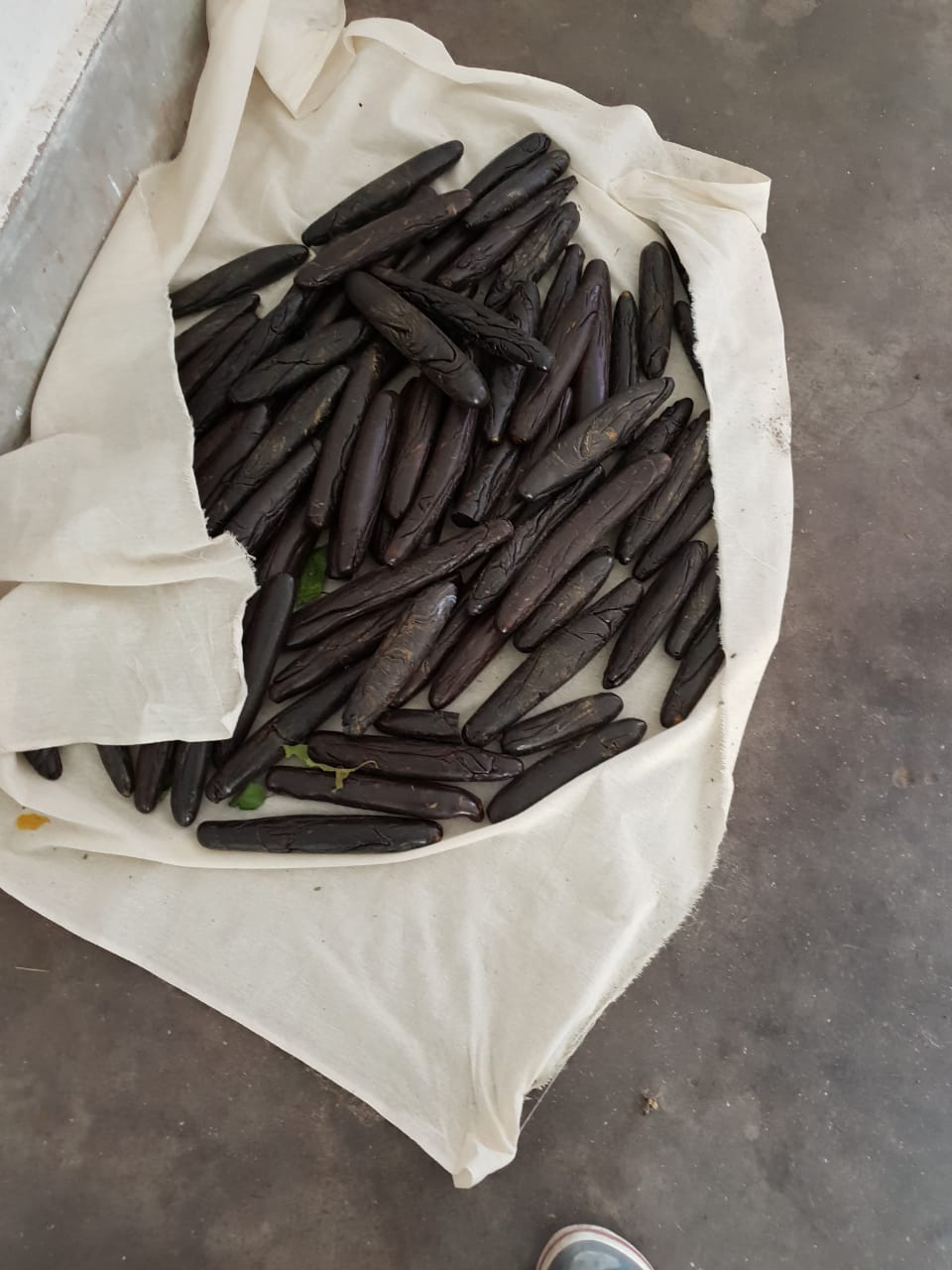
Seal Shellac Gulli
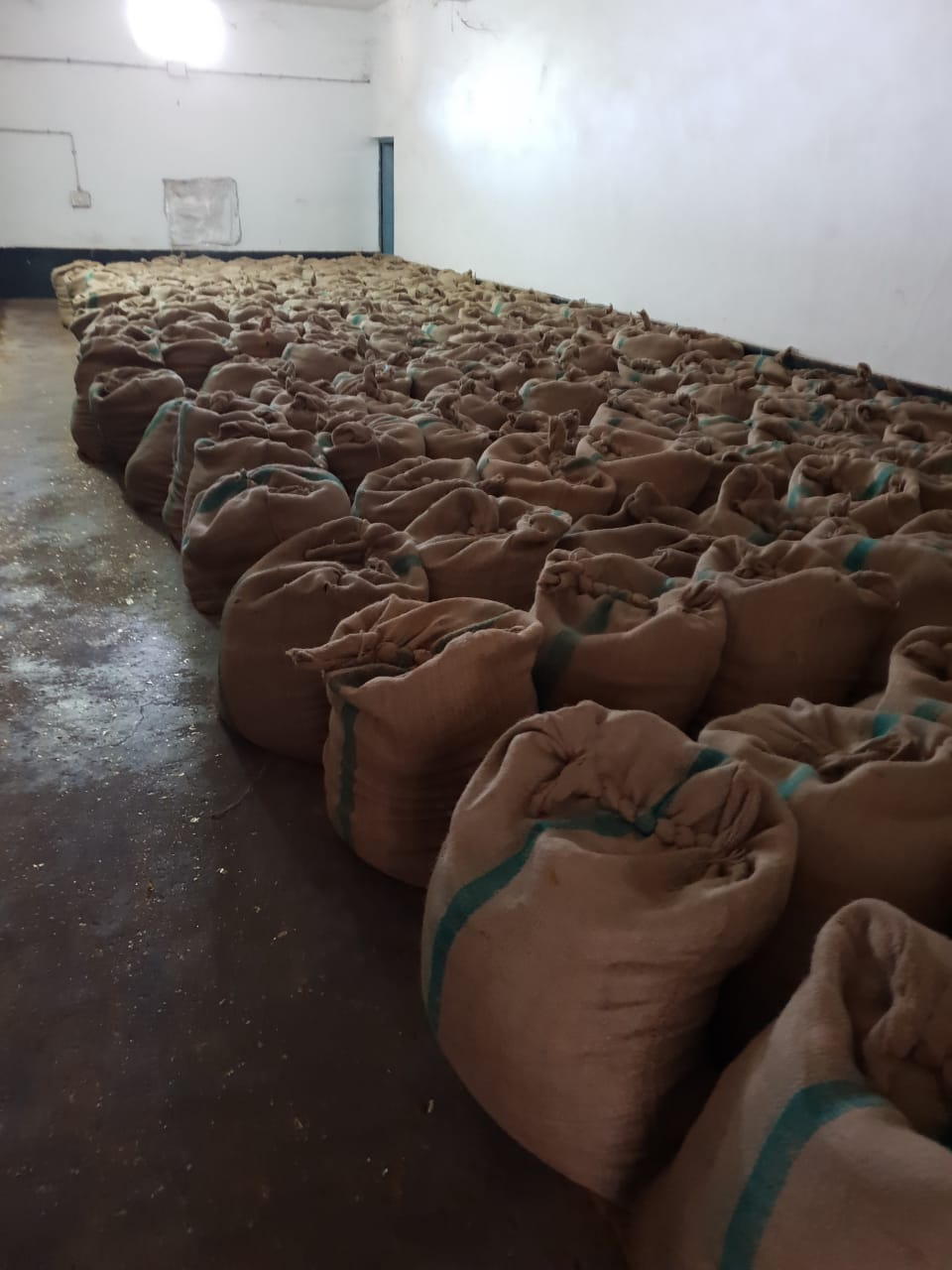
Packing and Storage of Shellac
Shellac is processed Seed lac which is subjected to melting. The melted lac is sieved through cloth and is given the final shape by molding. The final form of lac is called “Shellac”. And has over 90 percent resin content. Shellac and seed lac has a long shelf life and are stored in sacks in cooled rooms. Dhamtari however, does not have many melting units. Most of the melting units are either in Balarampur of West Bengal or in Odisha.
Lac Trading in Chhattisgarh
Jharkhand state ranks first followed by Chhattisgarh, Madhya Pradesh, Maharashtra and Odisha. These five states contribute around 95 per cent of the national lac production. Contribution of Jharkhand in national lac production is about 58 per cent followed by Chhattisgarh (16.1 %), Madhya Pradesh (11.9 %), Maharashtra (5.6 %) and Odisha (3.2 %) (ICAR 2014, Yogi 2015).
A major quantity of the 16 percent share of Chhattisgarh in the total national average comes from Bastar. Stick lac in small quantities are generally sold in rural markets (haats) by the lac rearers. Rural markets (haat) in remote lac growing areas of bastar operate once or twice in a week. Lac rearers, after harvesting stick lac sell to paikars (primary purchasers). Lac rearers of Dhamtari and Charama owing to their proximity to lac processing units, also sell their produce directly to processing units. The paikars after aggregating large quantities of stick lac in the course of the market day, sell it to the wholesaler in the same market or to the closest processing units. In Southern Chhattisgarh almost all the processing units are in Dhamtari, hence all of the aggregated lac finally goes to Dhamtari in bigger lots. Simultaneously, the wholesalers sell the produce to processing unit owners after an initial sorting of the kusmi lac from pharsa lac. Dhmatari is known for its kusmi lac processing centers. After processing, lac is sold to shippers and larger traders who export most of the produced shellac out of the country via the port of Kolkata. USA followed by Switzerland, Germany and other European countries are the major importers of kusmi Shellac (Yogi et al 2015). The international trade of lac is monitored by Shellac and Forest Products Export Promotion Council (SHEFEXIL) (Yogi 2015). Lac is an essential component in a host of industrial products ranging from pharmaceuticals, electronics, sealants dyes, paints and polishes.
Lac as Livelihood
The State Government of Chhattisgarh recognized Lac rearing as an essential livelihood activity and in order to protect rearers from scrupulous traders and fluctuating market prices of lac introduced the Minimum Support Price and a strategy to distribute Brood lac. Recommendations of Minimum Support Price of lac targeted both rangeeni variety (harvesting season is May-June & October-November) and kusumi variety (harvesting season is January-February & July-Aug). Brood lac distribution was initiated as the production of lac is mainly dependent upon inoculation of brood lac by rearers on the lac host trees in time.
Accordingly, based on the inputs provided by IINRG, Pricing cell of the state government recommended the introduction of Minimum Support Price (MSP). The market price of lac is determined by processors and exporters, but rearers/primary collectors get protected through the price based on the cost of the production which may vary depending upon the cost of brood lac for the season (Yogi 2015). An example at this juncture might help to illustrate:
In the year 2015, the Lac Cultivators have used brood Lac of July 2014 crop in their cultivation. The prices of Brood lac in 2014 were ranging between 300-350/kg (Yogi 2015), hence cost of production of lac would have been higher during harvesting season in December and January. Given the scenario IINRG submitted a detailed cost sheet for determining the cost of production for each variety of lac for the season in 2015. The Pricing cell recommended enhancing the previous MSP by 10 per cent which ensured that the increased production cost does not affect the rearers.
Climate Change and Lac Rearing
Lac as an industry has been on the slippery slope for over a few decades. Although 2012 was seen as a sudden high point but overall it has been a story of gradual failure of institutional mechanisms and policy. The total output of lac from Chhattisgarh has dropped from 2500 tonnes in 1987-88 to less than 1400 tonnes currently (Gupta 2015). A basic survey by IINRG and ICAR suggests that only 10 percent of all possible host plants are utilized for lac rearing. Various other factors add to it, such as the forest dwelling communities do not look at kusum only as a host tree for lac. Given that they look at it as a primary component of their habitat, making a profitable crop of lac from it does not sound too lucrative for them, instead they see it as a threatening practice as too much of lac production can cause a tree to shrivel up from inside and die as the lac insects are voracious sappers of tree sap. Lac insects also attract a whole host of pests and animals who cause considerable harm to the trees. Most of the processing unit owners blame the policy of the state to distribute cheap quality brood lac which not only affects production but also discourages rearers from developing their own brood lac. A group of scientist however added to the already long list of factors affecting the production of lac, the factor of climate change which is transforming the sexual behavior of the lac insects. A Down to Earth article reports that:
“lac production has been declining steadily over the past few years. Scientists would cite shrinking forest cover and poor farming practices as the reason. But a study has now shown that another, far more perilous, factor might be at play: climate change.” (Gupta 2015)
Investigating further on the issue one can find farmers and entrepreneurs such as Surya Kumar Dhruv of Chapeli and Basant Yadav complaining about the problems of rising temperatures in the forest and melting of lac encrustations especially during the summer months as well as a major reduction of female lac insects. Senior scientist of IINRG Ramani also points out that high temperature disturbs gender ratio among lac insects. “Studies have shown that population of males increases dramatically because of high temperature,” he says. Since, it’s only the females that secrete lac, decrease in their number has a detrimental effect on lac production (Gupta 2015).
Conclusion
As I have mentioned in the introduction this article cannot be exhaustive at any degree. Before I conclude I would like to add, that although lac is an essential commodity and has emerged as a possible alternative livelihood it still remains largely divorced from the life of the adivasis. It is hailed as a commodity of the future by various developmental agencies, but unfortunately it does not hold a place of significance in the life and cultural practices of the adivasis in a way that mahua, harra, bahera or imli does. It is a cash crop and it is often treated as a means of additional income. Unlike other forest produces of Chhattisgarh, lac remains a product which becomes alive in its commercial afterlife in the global markets.
References
EPW.“Bastar: Development and Democracy” Economic and Political Weekly, Vol. 24, No. 40 (Oct. 7, 1989), pp. 2237-2241.
URL: http://www.jstor.org/stable/4395427
Sivaramakrishnan, K. Modern Forests: Statemaking and Environmental Change in Colonial Eastern India. Stanford University Press, 1999
Mandal, J.P & Sarkhel, J. Analysis of Cost Effectiveness of Lac Processing in Purulia District. Business Spectrum, Vol.4, No.2 (Jul-December 2014).
URL: http://admin.iaasouthbengalbranch.org/journal/8_Article5.pdf
Mandal J, P. “A study of Problems and Prospects of Lac Industry in Purulia, District West Bengal” submitted to Burdwan University, West Bengal.
URL: http://hdl.handle.net/10603/121488
Yogi. R.K et al. Lac, Plant Resin and Gum Statistics 2014: At a Glance. ICAR-Indian Institute of Natural Resins and Gums (IINRG), 2015
Ramnath. M. Woodsmoke and Leafcups: Autobiographical footnotes to the anthropology of the Durwa. Harper-Collins, 2105
Samiksha, S. Lac-insect for Lac Culture in India: Life Cycle of Lac-insect (with pictures). http://www.yourarticlelibrary.com
Gupta, A. Lac Melts. Down to Earth. August, 2015
URL: https://www.downtoearth.org.in/news/lac-melts-41791
This content has been created as part of a project commissioned by the Directorate of Culture and archaeology, Government of Chhattisgarh to document the cultural and natural heritage of the state of Chhattisgarh.













